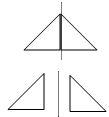 Grade 4
Grade 4
TransformationsStep 1: Identify Outcomes to AddressGuiding Questions
Big IdeasCongruency and symmetry are geometric properties. These properties can be used to determine what makes some shapes alike and different. Congruent 2-D shapes are "geometric figures that have the same size and shape" (Alberta Education 1990, p. 198). Symmetrical 2‑D shapes are geometric figures "that can be folded in half so that the two parts are congruent" (Alberta Education 1990, p. 205). Symmetrical and congruent shapes are closely connected. Any symmetrical shape can be divided into two congruent parts along the line of symmetry; however, not every composite shape made up of congruent figures is symmetrical. For example,
A shape remains the same size and shape when transformed using translations, reflections or rotations; i.e., the object and the image in these transformations are congruent. Symmetrical shapes form a subset of reflections. A reflection results in a symmetrical composite shape when the mirror line used to reflect a shape aligns with one side of the shape. For example:
|
||||||||||||||||||||||||||||||||||||||||||||||













